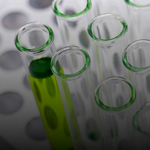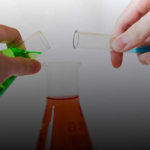Section 1
Preview this deck
WHat are the chemical reactions in catabolic reactions?
Front
Active users
0
All-time users
0
Favorites
0
Last updated
5 years ago
Date created
Mar 1, 2020
Cards (71)
Section 1
(50 cards)
WHat are the chemical reactions in catabolic reactions?
hydrolysis
What is metabolism?
the sum of all the chemical reactions in your body
What does catabolism do?
It breaks up stuff most liberate energy- (excess energy)
What do enzymes compare to and what do they help?
enzymes are our engines on a cellular level they help to produce energy
What is the reaction of catabolism, which produces the energy?
ATP -> ADP + Pi
Explain the relationship between the change in mass and the molarity of sucrose within the dialysis bags.
The relationships between the change in mass and the molarity of sucrose within the bag is the mass increased once the distilled water diffused into the dialysis bags.
What affects the enzyme's environment?
ph inhibitors and activators Temperature salt
What are the chemical reactions in anabolic reactions
dehydration synthesis because where we put things together
What does exergonic tend to be?
catabolic
WHy did the elodea cell plasmolyze?
The elodea cell plasmolyzed because when the salt water was added the central vacuole shriveled up.
How do you get to anabolism
You have to get thhrough metabolism before going through anabolism
What does entropy tend to be?
anabolic
How do enzymes speed up metabolic reactions?
by lowering energy barriers.
Is ATP a monomer or a polymer?
monomer
Where does energy come from?
catabolism
What is plasmolysis>
PLasmolysis is the shrinking of the cytoplasm of a plant cell in response to diffusion of water out of the cell and into a hypertonic environment surrounding the cell.
Explain the results you obtained. Include the concentration differences and membrane pore size in your discussion.
For the glucose, the bag was hypertonic compared to the beaker. The cell membrane pore is bigger than the the KI pore, so the starch did not diffuse into the beaker.
What is the reaction for anabolism?
ADP + Pi -> (it creates) ATP
What does ATP stand for?
Adenosine Triphosphate
In the winter, grass often die near roads that have been salted to remove ice. What causes this to happen?
The grass was plasmolyzed when the salt was added.
WHat is anabolism?
It consumes energy
What does is the enzyme in this lab?
catalase
What does ADP stand for?
Adenosine di phosphate
Based on your observations, rank the following by relative size, beginning with the smallest: glucose molecules, water molecules, IKI molecules, membrane pores, starch molecules.
1. IKI molecules 2. water molecules 3. membrane molecules 4. glucose molecules 5. starch molecules
WHat are the three metabolic pathways
substrates intermediate end products
How does ATP provide energy for metabolism?
ATP breaks down - one phosphate is transferred to other molecule releasing energy needed for endergonic reactions (this is how I transfer energy)
What is ATP?
energy currency of the cell WHen the AtP breaks it down it uses the energy for cellular work
WHat does entropy take?
takes energy to organize- entropy allows everything to spread out -> disorder
What id the chemical reaction in this lab
2H2O2(g) -> 2H2O(g) + O3 (g)
What will happen if the two substrates are together and they make a reaction?
because they fit
WHat is the product in this lab?
H2O + O2 (g)
What does the arrow indicate in the chemical reaction?
catalase
What results would you expect if the experiment started with a glucose and IKI solution inside the bag and only starch and water outside? Why?
I think the beaker would change color, and the bag would stay the same. SInce the IKI solution has small pores it would diffuse into the beaker creating the color change.
Cells need energy to move to do what?
the whole cell (flagella and cilia TO change shape of cell movement within cells (molecules, etc...)
What are catalysts?
chemical agent that accelerates a reaction without being permanently changed during the reaction
What does Pi stand for?
- ( i = inorganic) phosphate
What is the abbreviation for E +S -> ES -> E +P
Enzyme + Substrate -> Enzyme Substrate product-> Enzyme + Product
What are the three phosphates made up of?
POP is energetic two POP make up the phosphate
What makes up the nucleotide of ATP?
it has a nitrogenous base = its adenine it has 5- carbons and it has 3 phosphates
For what purposes do cells need energy?
To maintain homeostasis and organization To move Making Molecules - Biosynthesis Biochemical pathway (many reactions -- needing much energy - in small doses)
What is endergonic?
a reaction that requires energy to happen (net use of energy)
What is the substrate in this lab?
H2O2
What type of macromolecule is ATP?
a nucleotide
Why did you calculate the percent change in mass rather than simply using the change in mass?
The percentage change in mass helps show how much of the water has diffused into the dialysis bag.
Which substances are entering the bag and which are leaving the bag? What experimental evidence supports your answers?
KT entered the bag. Glucose left the bag. The bags color changed the purple that's how we know that KI entered the bag. The beaker's color did not change which means that the starch did not go into the beaker.
What is exergonic?
reaction that produces energy ( net loss of energy)
Quantitative data uses numbers to measure observed changes. How could this experiment be modified so that quantitative data could be collected to show that water diffused into the dialysis bag?
We could record the proportion of the ingredients which would show that water diffused into the dialysis bag.
What does nothing happen when the water and hydrogen peroxide are together?
Because they have different shapes
What is entropy
the state of disorder
Predict what would happens to the mass of each bag in this experiment if all the bags were placed in a 0.4M sucrose instead of distilled water. Explain your response.
The mass of each bag would stay the same because both substances have sucrose in it. They would diffuse until they reached equilibrium, Since the bags were placed in distilled water, the water diffused into the bag making the mass increase.
Section 2
(21 cards)



